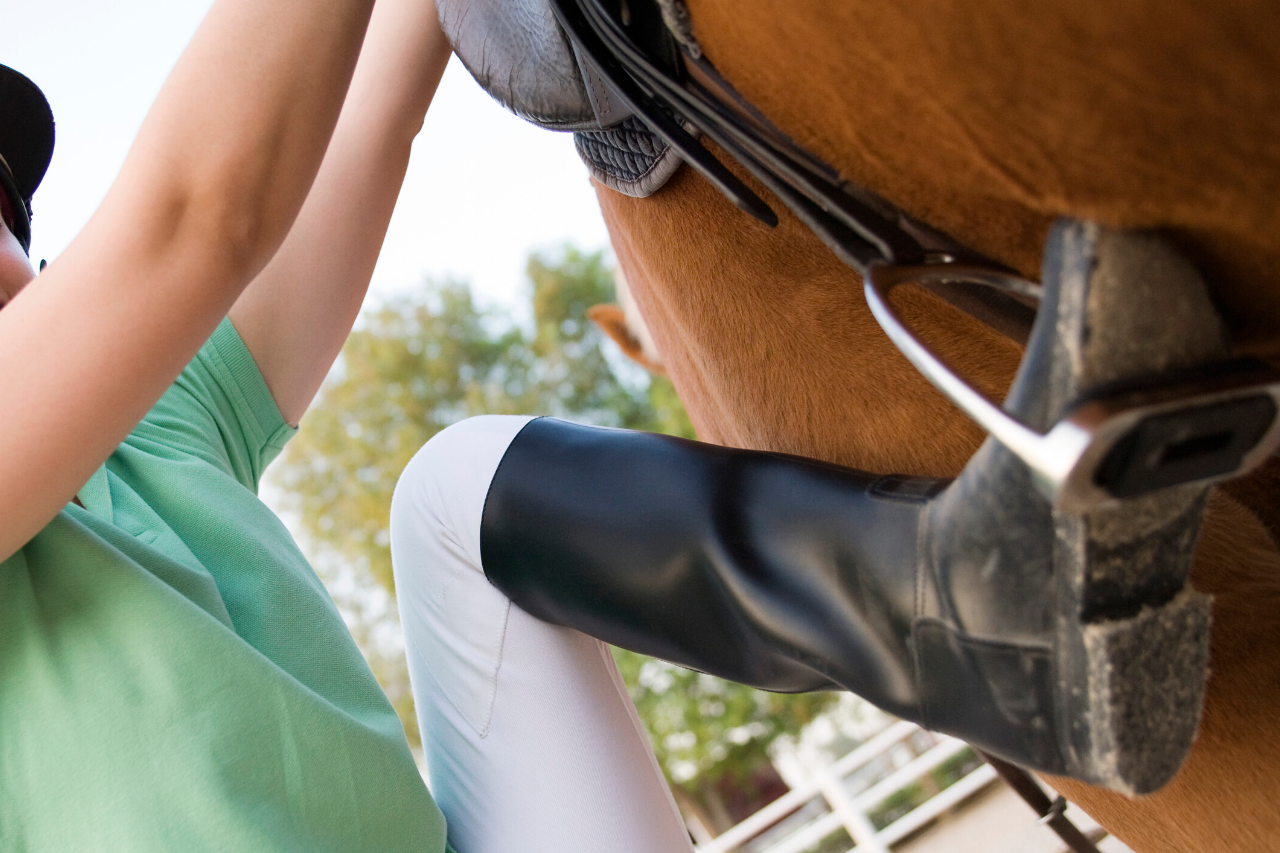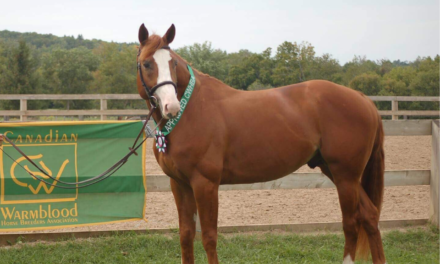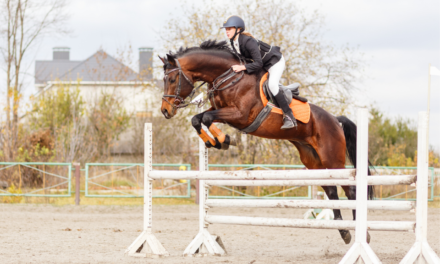We may earn money or products from the companies mentioned in this post. For more information please check out our disclosure page
Do you have a horse that doesn’t want to stand quietly to be mounted?

.
There is nothing worse than fighting with your horse at the mounting block! I have faced this problem with so many horses when I first get them so I totally get how frustrating it is!
Ultimately a horse should walk to the mounting block and stand quietly without moving so you can climb up and get on.
This ariticle will give you all the tips and tricks I use to help my horses learn to stand still.
Mounting from the ground can be hard on both you and your horse’s back so I always mount from a mounting block.
Short Story – My Worst Case Horse
A few years ago I leased out one of my horses to someone and when the lease ended he was un-mountable both from the mounting block and the ground. He would pull back, spin, and rear up, ANYTHING to avoid going anywhere near the mounting block.



He had learned this behavior in a very short time with the person who had leased him. For whatever reason he was not happy being ridden by this person and he started to act up at the mounting block.
On numerous occasions after he refused to be mounted the rider would put him away without riding him. He learned that his bad behavior was rewarded with not being ridden – so he got worse!
When I got the horse back he was a nightmare. He already had lots of previous training in all his ground work exercises yet as soon as he went remotely close to the mounting block he started rearing and pulling back.
I realized I would need to confuse him and change his thought process in relation to the mounting block. The following process took 11 days:
(NOTE: I don’t use treats to train horses however, with this particular horse I used them because he was so distracted and stressed by the mounting block. If you find your horse is very reactive to going close to the mounting block feel free to use treats)
1. Day One
Groundwork! Does it ever end? NO!
Do lots of walk-halt-walk transitions leading your horse.
Move the mounting block away from its usual place in the arena and walk your horse around it, be sure to ignore it and continue to do your walk-halt-walk exercises.
Once your horse will stand still at the halt you can add the mounting block into your groundwork and continue with walk-halt-walk transitions on a circle, making sure you get your horse to halt at or near the mounting block.
USE TREATS TO GET HIS ATTENTION ON YOU AN AWAY FROM THE MOUNTING BLOCK
Be sure to reward your horse whenever he is responsive.
If your horse is pushy and not listening, do a few rein backs. Put some pressure on his chest with your hand, tap him on his chest, or you can also apply pressure from the reins. Once your horse has responded by stepping backward, make sure to release the pressure.
Asking in a pressure-release fashion, your horse will soon understand and respond correctly.
Don’t forget to use voice commands while doing groundwork exercises!
If you are not sure about how to do groundwork exercises sign up for my free guide that explains 9 basic exercises and how to do them.
2. Day Two
Move the mounting block so it is facing the arena wall and there is about a 10 foot distance between the mounting block and the wall.
Repeat the walk-halt-walk and back up groundwork exercises in a circle and include walking through the space between the mounting block and the wall. (I always stay well out of the horses’ way while going through the space in case they run forward).
Gradually include the halt in the space between the mounting block and the wall. Give your horse a treat and lots of praise to encourage him to stand.
Most horses accept this, however, the ‘worst case’ horse mentioned above was resistant at first but patience and treats won him over!
Why make a space between the mounting block and the wall?
You need to take away the opportunity for the horse to swing their butt away from the mounting block and force them to stay straight without putting any pressure on them.
You need to be able to focus on the horse being obedient going forward and backwards and avoid having to correct the sideways movement.
Working on sideways movement will be done after the horse has been taught to stand still.
REMEMBER – The purpose of not trying to mount for the first few days is to change your horses thought process.
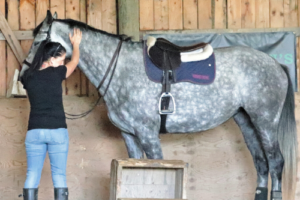
.
3. Days Three and Four
Place a grooming kit on the mounting block.
Start with the walk-halt-walk exercises in a circle which includes going through the space between the mounting block and the wall.
Once your horse is responding correctly get them to halt in the space and groom them.
On the 3rd day groom your horse from the ground.
On the 4th day use the mounting block to groom your horse to get him used to you stepping up onto it but not mounting him.
I have to tell you that my ‘worst case” horse was super alert and very wary of what was going on. He was still not keen on being close to the mounting block but I patiently waited and kept asking him to stand until he would stand EXACTLY where I wanted him to.
He attempted backing up a step or trying to step forward, but having done the walk-halt-walk groundwork over and over he was more willing to listen and less inclined to run forward or fly backwards.
His flight response had dulled down and he was starting to trust me. At this point he was merely testing the waters to see if he could get away with it but I was right there to gently correct and reward him.
To get him to stand in the space I used treats (I don’t usually use treats for groundwork but his case was extreme and anything that works to get him to want to stay was a good thing)
HORSE TIP – Don’t do what they are expecting you to do when you are dealing with an issue like this.
Your horse has been viewing the mounting block as a place he doesn’t want to be. We have to make him believe it is a place he WANTS to be.
Now the space he didn’t’ want to go to was becoming a place where he got his favorite snacks and some loving attention.
By doing this we are starting to change the way he feels about it.
4. Day Five
Repeat Day 4. When grooming the horse on the mounting block SAFELY put some weight against the horse by casually leaning over supporting yourself with one hand and using a brush on the offside (far side) of the horse.
Make very casual movements while doing this so that you can gauge your horses reaction.
Encourage your horse to stay still and correct any little movements they make.
If you use a blanket, blanket your horse from the mounting block and end the session.
My ‘worst case’ horse was pretty skeptical at this point! I could tell he was thinking “lady you are stupid if you think I am falling for this” .I was thinking “and you are stupid if you think I don’t know that”.
REMEMBER! Don’t do what they are expecting you to do!
5. Day Six, Seven, and Eight
You are going to add your horses saddle to the equation for these three days. Make sure you take your saddle, girth, saddle pad, and grooming kit to the mounting block before you bring your horse.
Repeat the halt-walk-halt groundwork as you have done the other days
Bring your horse to the mounting block space and groom, then saddle up while asking your horse to remain still. we are not bridling at this point.
At this point your horse may expect you to try to get on and their body language may show you they are ready for act out the way. IGNORE this behaviour and patiently correct your horse until they stand still for a couple of seconds.
Once your horse has stood still lead him out of the space between the mounting block and the wall, unattached the rope from his halter and sent him off to have fun trotting around the arena.
The purpose of this is to teach your horse over time that the mounting block isn’t always a place where someone gets on, even with tack on!
Let your horse play for a while then catch them, bring them back into the space and untacked, groom, blanket, give him treats and put him away.
BY DAY 8 WITH MY WORST CASE HORSE I COULD FEEL A SHIFT IN ATTITUDE WHEN IT CAME TO WALKING INTO THE SPACE BETWEEN THE MOUNTING BLOCK AND THE WALL.
He was much more relaxed and showed little concern as to what I was asking him to do
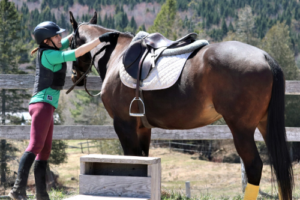
.
6. Day Nine
Repeat Day 8 and this time bridle your horse
After bridling get on the mounting block and hold the reins as if you are going to mount,
Then lift your foot as if you are going to put it in the stirrup iron.
Repeat a few times without mounting and without putting your foot in the stirrup iron.
Then get off the mounting block, secure the reins in the throat latch and allow your horse to go off and play.
FOR EVERY POSITIVE REACTION FROM YOUR HORSE GIVE HUGE PRAISE.
HUGE REWARDS FOR LITTLE STEPS
7. Day Ten
Repeat Day nine but this time, when your horse shows no reaction to you lifting your leg place it in the stirrup iron and mount making sure to sit down lightly to ensure a pleasant experience for them.
After 30 seconds or so dismount onto the mounting block, gave them some affection and praise, then mount again.
Repeat this three times then run up the stirrups, secure the reins in the throatlatch, give your horse lots of praise, and let him go for a play.
Finally catch them, bring them back to the mounting block to untack, groom, and blanket.
8. Day Eleven
Repeat day ten except on the third time mounting encourage your horse to away and go for a ride.
AFTER THESE 8 STEPS MY ‘WORST CASE’ HORSE HAS NEVER HAD A PROBLEM BEING MOUNTED
FINAL NOTE – you may be able to do the steps in less days if your horse is progressing well.
If your horse is still reactive repeat a day or two from the stage you feel he got stuck at.
PATIENCE IS KEY!
Learn to read your horses body language and reactions to know whether you are ready to move to the next step.
What if your horse swings away from the mounting block?
Horses’ I train the above way tend not to swing when they are later asked to approach the mounting block BUT if you find your horse does this, either step down from the block and straighten him or try to tap him lightly with the whip on his hindquarters to encourage him to move back toward the block.
This post may contain affiliate links. Please read our disclaimer for more info.
admin
Latest posts by admin (see all)
- A Horse For All Reasons – Guest Blog by Lucy from Horse Factbook - April 8, 2020
- How To Deal With A Spooky Horse Trail Riding - March 31, 2020
- Our Top 20 Amazon Equestrian Products - January 30, 2020

